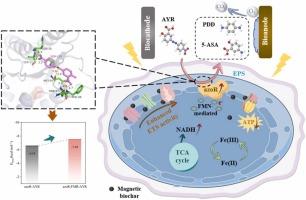磁性生物炭在生物电化学系统中促进偶氮染料降解:来自碳代谢、电子转移和分子对接的机制见解
IF 11.3
1区 环境科学与生态学
Q1 ENGINEERING, ENVIRONMENTAL
引用次数: 0
摘要
本研究以秸秆为原料合成了铁基磁性生物炭(FMB),并在与曝气膜生物膜反应器集成的生物电化学系统中对其在偶氮染料降解中的作用进行了全面研究。实验结果表明,30%铁负载的FMB通过降低生物膜氧化还原电位和电荷转移电阻,达到了最高的脱色和矿化效率。FMB的表征表明,表面官能团(如C=C, C=O)和Fe₃O₄颗粒增强了体系内的电子转移。细胞外聚合物(EPS)氧化还原活性成分含量增加,蛋白质α-螺旋含量增加4.61%,生物膜的电活性增强。亚转录组学分析表明,FMB调节碳代谢、电子传递链和血红素生物合成,促进电子流向偶氮还原酶基因azoR,并上调其表达。此外,在阴极和阳极生物膜中,Aquaspirillum sp. LM1和parcaligenes sp. KSB-10分别被鉴定为azor的优势表达种。分子对接进一步证明FMB可以自发结合azoR,降低azoR- ayr配合物的结合自由能,加速偶氮键的裂解。本研究为了解磁性生物炭强化偶氮染料废水处理的机理提供了新的思路。本文章由计算机程序翻译,如有差异,请以英文原文为准。

Magnetic biochar-facilitated azo dye degradation in bioelectrochemical system: Mechanistic insights from carbon metabolism, electron transfer, and molecular docking
In this study, Fe-based magnetic biochar (FMB) derived from straw was synthesized and comprehensively investigated for its role in enhancing azo dye degradation in a bioelectrochemical system integrated with a membrane-aerated biofilm reactor. Experimental results revealed that FMB with a 30% iron loading achieved the highest decolorization and mineralization efficiency of alizarin yellow R (AYR) by lowering the biofilm redox potential and charge transfer resistance. Characterization of FMB indicated that surface functional groups (e.g., C=C, C=O) and Fe₃O₄ particles enhanced electron transfer within the system. Moreover, extracellular polymeric substances (EPS) exhibited an increased content of redox-active components, and the α-helix content in proteins increased by 4.61%, enhancing the electroactivity of the biofilm. Metatranscriptomic analysis indicated that FMB modulated carbon metabolism, the electron transport chain and heme biosynthesis to facilitate electron flow toward azoR, the gene encoding azo reductase, and upregulate its expression. Additionally, Aquaspirillum sp. LM1 and Paralcaligenes sp. KSB-10 were identified as the dominant azoR-expressing species in the cathodic and anodic biofilms, respectively. Molecular docking further demonstrated that FMB could spontaneously bind to azoR, reducing the binding free energy of the azoR-AYR complex and accelerating azo bond cleavage. This study provides insights for understanding the mechanisms of magnetic biochar in enhancing the treatment of azo dye wastewater.
求助全文
通过发布文献求助,成功后即可免费获取论文全文。
去求助
来源期刊

Journal of Hazardous Materials
工程技术-工程:环境
CiteScore
25.40
自引率
5.90%
发文量
3059
审稿时长
58 days
期刊介绍:
The Journal of Hazardous Materials serves as a global platform for promoting cutting-edge research in the field of Environmental Science and Engineering. Our publication features a wide range of articles, including full-length research papers, review articles, and perspectives, with the aim of enhancing our understanding of the dangers and risks associated with various materials concerning public health and the environment. It is important to note that the term "environmental contaminants" refers specifically to substances that pose hazardous effects through contamination, while excluding those that do not have such impacts on the environment or human health. Moreover, we emphasize the distinction between wastes and hazardous materials in order to provide further clarity on the scope of the journal. We have a keen interest in exploring specific compounds and microbial agents that have adverse effects on the environment.
 求助内容:
求助内容: 应助结果提醒方式:
应助结果提醒方式:


